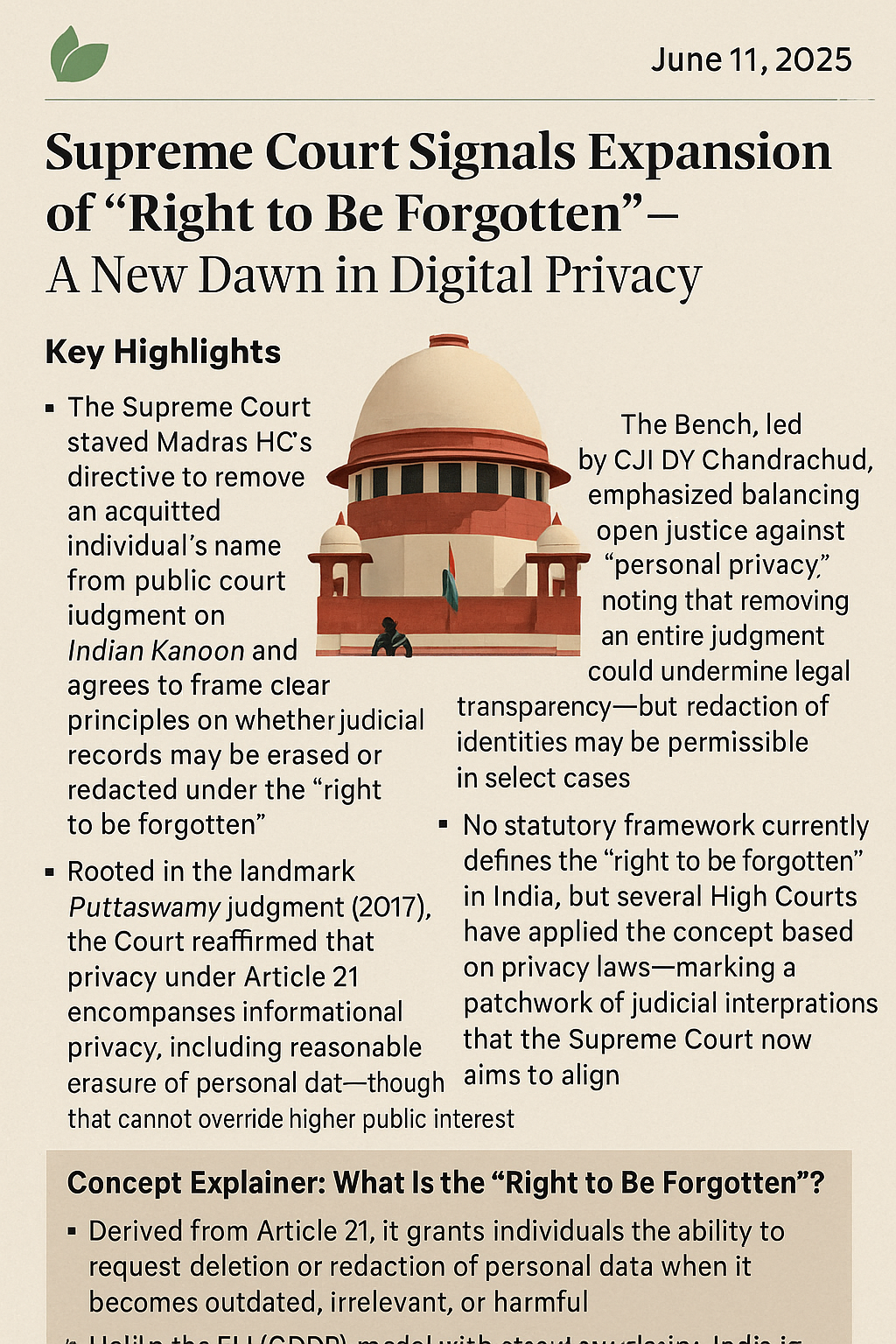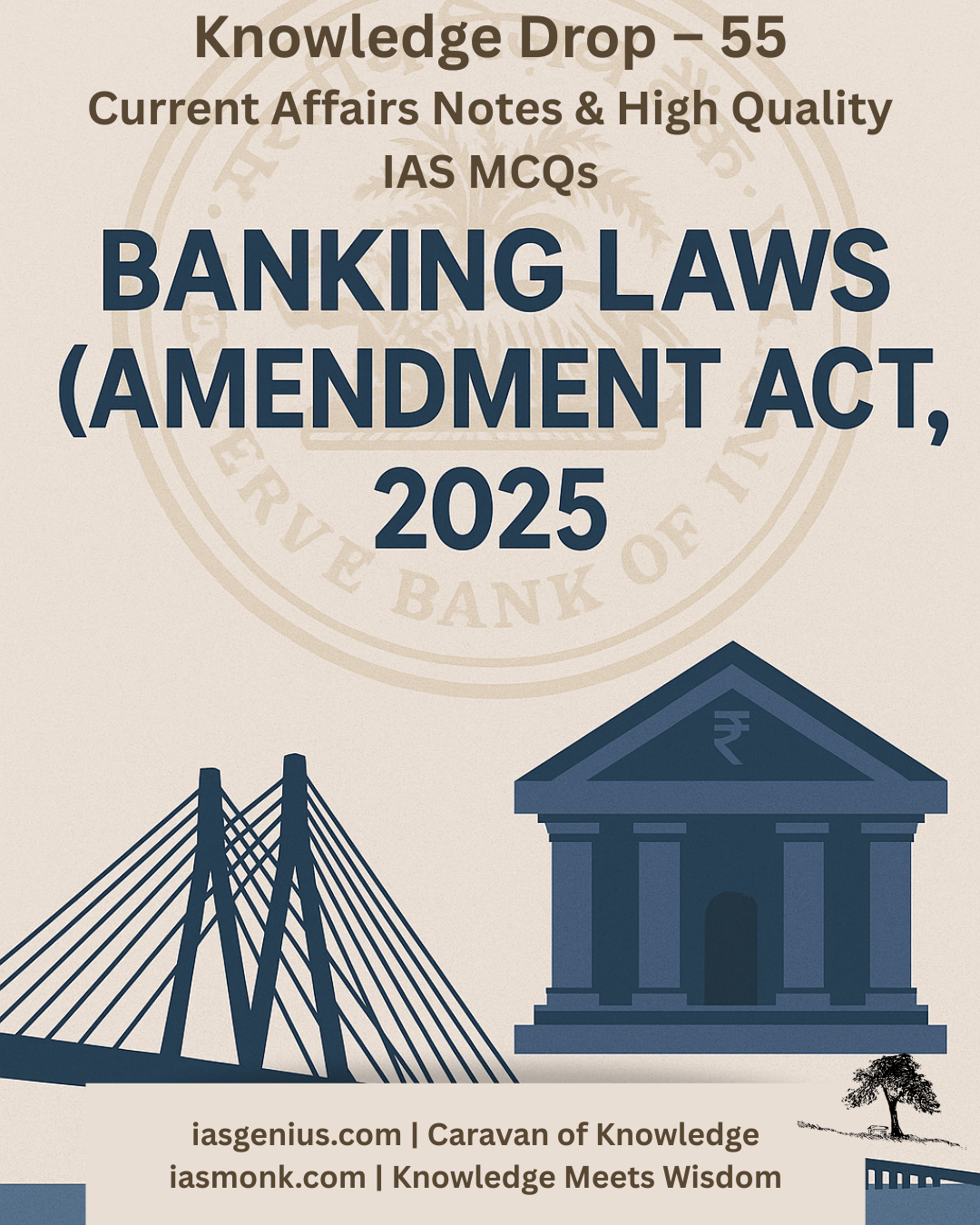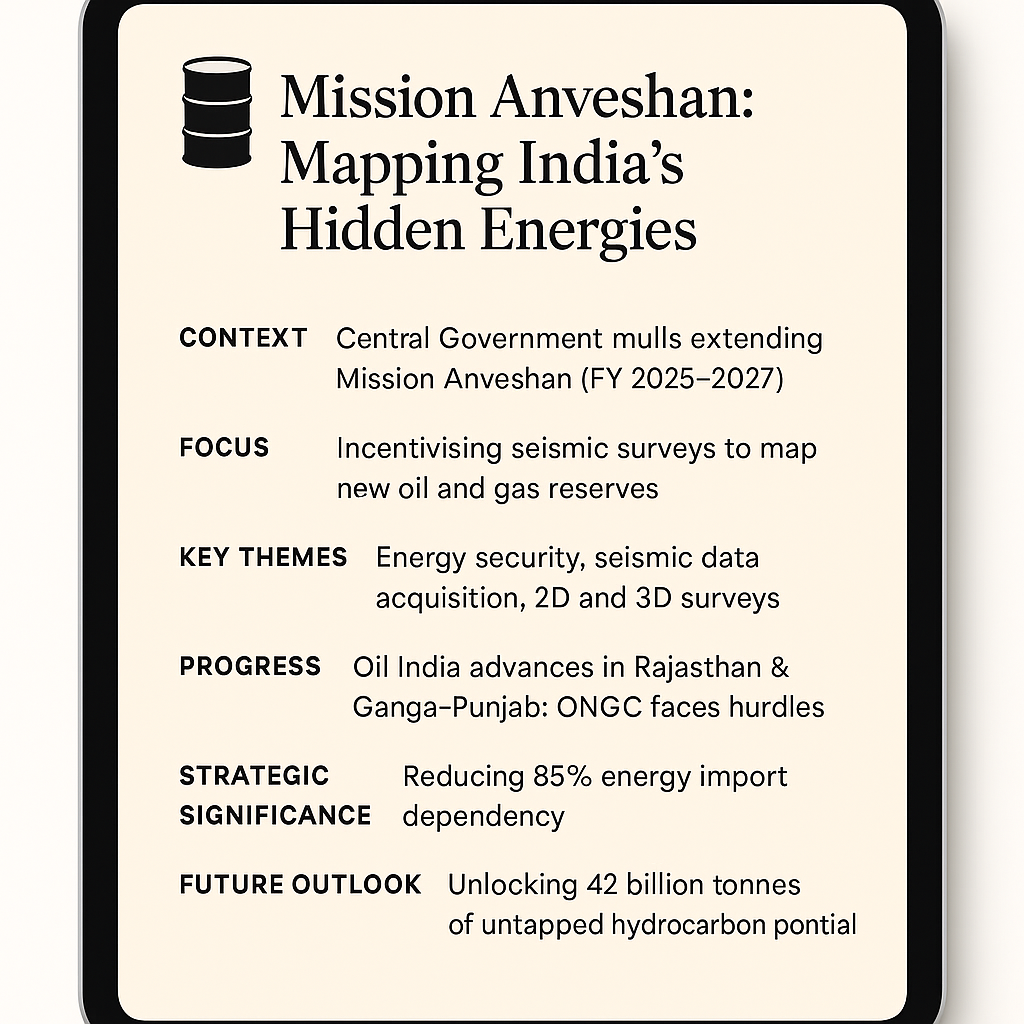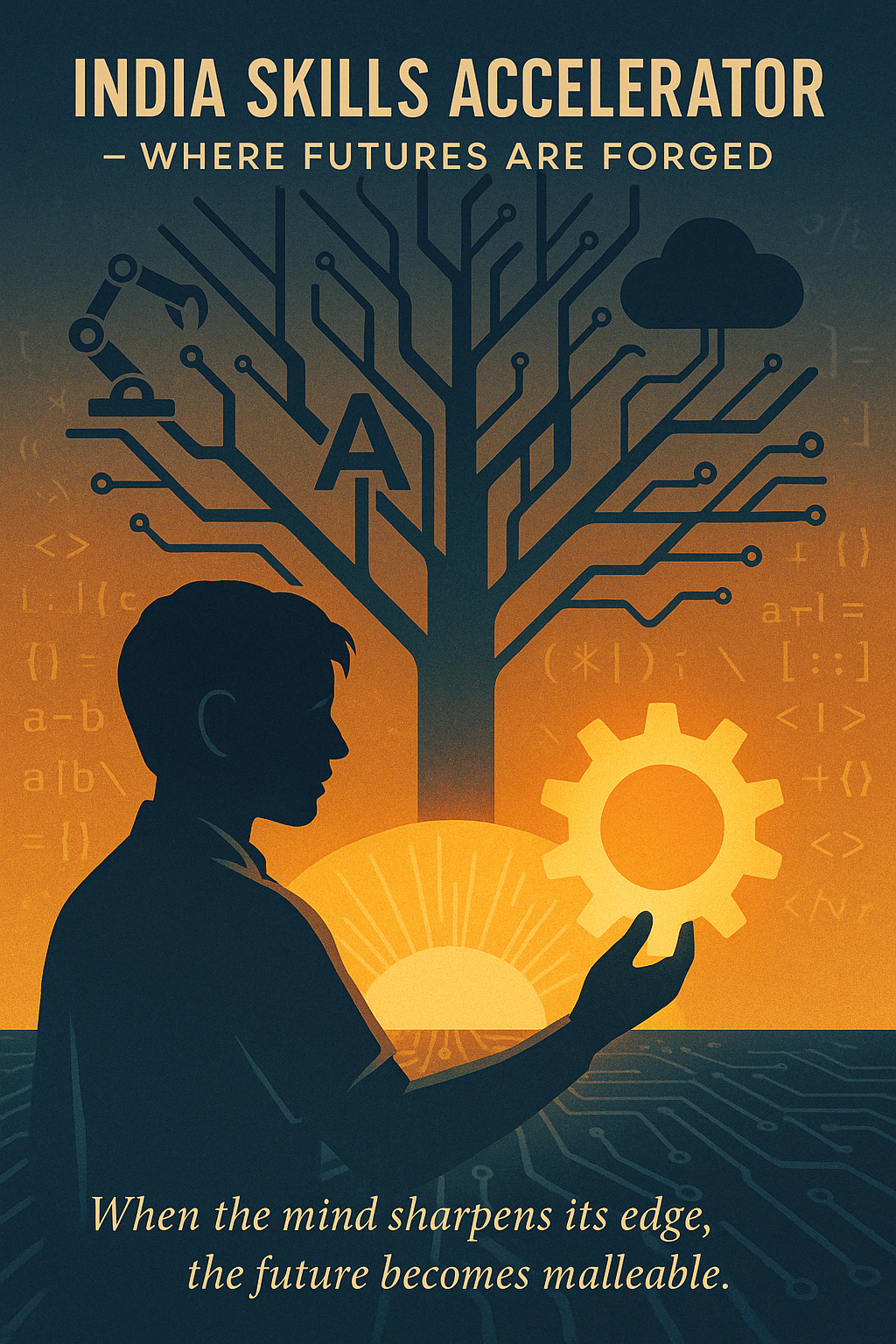
🧭June 11, 2025 Post 4: Supreme Court Signals Expansion of “Right to Be Forgotten” — A New Dawn in Digital Privacy | High Quality Mains Essay | Prelims MCQs
Supreme Court Signals Expansion of “Right to Be Forgotten” — A New Dawn in Digital Privacy

NATIONAL
📅 Post Date: June 11, 2025
📘 Thematic Focus: Polity & Governance | Fundamental Rights | Digital Privacy
🌿 Opening Whisper
“In the digital labyrinth, choosing what to lose can be as vital as choosing what to preserve.”
🔍 Key Highlights
- The Supreme Court has stayed the Madras HC’s directive to remove an acquitted individual’s name from a public court judgment on Indian Kanoon, and has agreed to frame clear principles on whether judicial records may be erased or redacted under the “right to be forgotten”
- The Bench, led by CJI DY Chandrachud, emphasised balancing open justice against personal privacy, noting that removing an entire judgment could undermine legal transparency—but redaction of identities may be permissible in select cases
- Rooted in the landmark Puttaswamy judgment (2017), the Court reaffirmed that privacy under Article 21 encompasses informational privacy, including reasonable erasure of personal data—though that cannot override higher public interest
- No statutory framework currently defines the “right to be forgotten” in India, but several High Courts have applied the concept based on privacy laws—marking a patchwork of judicial interpretations that the Supreme Court now aims to align
📘 Concept Explainer: What Is the “Right to Be Forgotten”?
- Derived from Article 21, it grants individuals the ability to request deletion or redaction of personal data when it becomes outdated, irrelevant, or harmful.
- Unlike the EU (GDPR) model with statutory clarity, India is guided by a piecemeal judicial approach—with High Courts often allowing redactions but upholding judicial record retention.
- The challenge lies in balancing privacy rights with the principles of open justice, freedom of expression, and public access.
🧭 GS Mains Mapping
- GS Paper 2 – Polity | Constitutional Guarantees | Right to Privacy & RTI
- GS Paper 1 – Modern Indian History | Judicial Activism & Right to Information/Digital Access
💭 A Thought Spark — by IAS Monk
“To forget is a gift of liberty; yet forgetting in the open court demands careful measure—justice must not surrender its memory.”
High Quality Mains Essay For Practice :
Word Limit 1000-1200
The Right to Be Forgotten: India’s Supreme Court Steps into the Digital Privacy Battlefield
Introduction
In an era where the internet immortalizes every name and every judgment, the human need to be forgotten has become a matter of dignity. On June 11, 2025, the Supreme Court of India reignited a crucial debate over digital privacy by deciding to frame comprehensive principles governing the “Right to Be Forgotten” (RTBF). This move comes after staying a Madras High Court order that directed the erasure of an acquitted individual’s name from a judgment hosted on a public legal archive.
While the idea of being digitally erased may appear to clash with ideals of open justice and archival integrity, the Court is now forced to answer a modern moral dilemma: Can justice be archived at the cost of personal ruin? This essay explores the legal roots, global precedents, ethical tensions, and future possibilities of RTBF in India.
Understanding the Right to Be Forgotten (RTBF)
The RTBF refers to the right of individuals to have personal information removed from public access when it becomes outdated, irrelevant, or disproportionate in relation to the purpose for which it was originally disclosed. Though widely recognized in the European Union under Article 17 of the General Data Protection Regulation (GDPR), India currently lacks statutory backing for this right. Instead, it has evolved through judicial interpretation of Article 21, which guarantees the right to life and personal liberty, including informational privacy.
The Puttaswamy Judgment (2017): A Foundational Pillar
In Justice K.S. Puttaswamy vs Union of India (2017), a 9-judge Constitution Bench unanimously declared privacy as a fundamental right, thus laying the constitutional foundation for RTBF. The Court acknowledged the dangers of unregulated data retention and emphasized the need for data minimization, purpose limitation, and the possibility of erasure in a democratic society.
The Current Case: Context and Implications
In the case under spotlight, an individual acquitted of charges had petitioned for their name to be redacted from a Madras High Court judgment publicly available on Indian Kanoon, an open-access legal archive. The High Court ordered redaction. However, the Supreme Court stayed that order, calling for a national legal framework on whether judicial records can be censored for privacy concerns.
Key Judicial Observations:
- Chief Justice DY Chandrachud noted that while privacy is fundamental, removal of entire judgments could disrupt legal transparency.
- However, selective redaction of names or personal identifiers could be a reasonable compromise in cases involving acquittals or non-convictions.
- The Court emphasized that open justice is not absolute and must accommodate evolving digital harms and mental trauma from permanent online stigma.
This signals the beginning of judicial codification of RTBF in India, especially for acquitted persons, victims of crimes, and juveniles.
Comparative Global Perspective
European Union
The EU GDPR explicitly provides the Right to Erasure (Article 17), allowing individuals to request deletion of personal data under specific conditions. The 2014 Google Spain Case (CJEU) ruled that search engines must delist outdated information if it causes disproportionate harm. However, this is not an absolute right and must be balanced with public interest, journalistic freedom, and archival importance.
United States
The U.S. follows a free speech-centric model, with strong protection for public records. RTBF has limited legal traction, and courts are hesitant to erase factual records, even when damaging to individual reputation.
India’s Middle Path
India is crafting a hybrid approach—acknowledging privacy without undermining transparency. SEBI, TRAI, and other regulators have begun issuing sector-specific data minimization norms. Now, the judiciary is shaping the RTBF selectively—not to erase records, but to safeguard individual dignity.
Arguments in Favor of RTBF
1. Reputation and Rehabilitation
Innocent individuals, especially in sensitive cases like sexual harassment, mental health, or minor offenses, often face permanent reputational damage. RTBF allows them to move on without digital scars.
2. Mental Health & Social Stigma
Persistent online visibility of past events—whether relevant or not—can lead to depression, social exclusion, and professional loss, violating the spirit of Article 21.
3. Data Minimization Principle
RTBF aligns with global data protection norms, emphasizing that data should not be stored or distributed beyond necessity.
4. Correcting Asymmetry of Power
RTBF empowers citizens to reclaim agency over personal data, which has been historically hoarded and monetized by platforms without consent.
Challenges and Counterarguments
1. Threat to Open Justice and Legal Archives
Public access to court records ensures accountability, prevents distortion, and supports academic/legal research. Removing names could weaken this transparency.
2. Slippery Slope of Censorship
A blanket RTBF could encourage wealthy or influential individuals to manipulate digital memory, erasing valid records to whitewash past actions.
3. Technical and Operational Complexity
Who decides what should be forgotten? Courts? Data Protection Authorities? Search Engines? Lack of procedural clarity may lead to arbitrary censorship.
4. Freedom of Press and Historical Truth
RTBF may infringe on journalists’ right to report past truths and on society’s right to remember historical events—especially involving public figures or criminal records.
The Way Forward: Balancing Memory and Mercy
Given the competing values of privacy, public interest, and free expression, a nuanced, multi-tiered framework is essential:
A. Statutory Recognition
India’s proposed Digital Personal Data Protection Act (DPDPA) must explicitly include RTBF, with clear grounds, exceptions, and procedures.
B. Judicial Guidelines
The Supreme Court may issue a multi-factor balancing test—evaluating public interest, role of the individual (public vs private), gravity of the allegation, and outcome of the case.
C. Time-Based Expiry System
Digital content relating to acquitted or discharged individuals could be set to auto-expire from search engines or be de-indexed after a defined number of years.
D. Redaction Instead of Erasure
Instead of deleting whole records, redacting personal identifiers from public portals (like Indian Kanoon) could strike a balance between memory and mercy.
E. Grievance Redressal Authority
A quasi-judicial board comprising privacy experts, legal professionals, and technologists could review RTBF requests and guide compliance.
Conclusion
The Supreme Court’s renewed focus on the Right to Be Forgotten is more than a privacy matter—it is a philosophical question on who controls memory in the digital age. Can one move on if the past is always searchable? Can justice exist without collective memory?
India, with its constitutional ethos rooted in both dignity and democracy, must construct an RTBF model that neither forgets the innocent nor erases the truth. In a world where algorithms never sleep, perhaps the court is right in asking: Should the law learn to forget, at least a little?
Target IAS-26: Daily MCQs :
📌 Prelims Practice MCQs
Topic:”Right to Be Forgotten” — A New Dawn in Digital Privacy
MCQ 1 – Type 1: How many of the above statements are correct?
Consider the following statements regarding the Right to Be Forgotten (RTBF) in India:
1. The Supreme Court has upheld the removal of entire court judgments from public databases under RTBF.
2. RTBF is derived from Article 21 of the Indian Constitution.
3. The Puttaswamy judgment of 2017 laid the constitutional foundation for privacy rights, including informational privacy.
4. There is currently no comprehensive law that explicitly codifies RTBF in India.
How many of the above statements are correct?
A) Only two
B) Only three
C) All four
D) Only one
🌀 Didn’t get it? Click here (▸) for the Correct Answer & Explanation
✅ Correct Answer: B) Only three
🧠 Explanation:
•1) ❌ False – The Supreme Court stayed removal of full judgments and proposed selective redaction instead.
•2) ✅ True – RTBF is interpreted as part of the right to life and privacy under Article 21.
•3) ✅ True – The 2017 Puttaswamy verdict upheld privacy as a fundamental right.
•4) ✅ True – India lacks a statutory RTBF; it exists only via judicial interpretation.
MCQ 2 – Type 2: Two Statements Based
Consider the following two statements:
1. The Supreme Court has directed that all criminal judgments involving acquittals must be removed from the internet.
2. The Court is attempting to balance open justice with personal privacy through redaction rather than erasure.
Which of the above statements is/are correct?
A) Only 1 is correct
B) Only 2 is correct
C) Both are correct
D) Neither is correct
🌀 Didn’t get it? Click here (▸) for the Correct Answer & Explanation
✅ Correct Answer: B) Only 2 is correct
🧠 Explanation:
•1) ❌ False – No blanket directive was issued for erasure.
•2) ✅ True – The Court is exploring redaction to safeguard privacy while preserving transparency.
MCQ 3 – Type 3: Which of the statements is/are correct?
Which of the following factors are critical in assessing the validity of RTBF requests?
1. Public interest in preserving judicial records
2. Whether the individual was convicted or acquitted
3. The professional and mental impact on the petitioner
4. The role of the individual in public life or media
Select the correct answer using the code below:
A) 1, 2 and 3 only
B) 2, 3 and 4 only
C) 1, 2, 3 and 4
D) 1 and 4 only
🌀 Didn’t get it? Click here (▸) for the Correct Answer & Explanation
✅ Correct Answer: C) 1, 2, 3 and 4
🧠 Explanation:
•1) ✅ True – Public interest is a key consideration.
•2) ✅ True – Acquittals often strengthen RTBF claims.
•3) ✅ True – Personal harm and reputation are evaluated.
•4) ✅ True – Public figures have reduced RTBF scope due to higher scrutiny.
MCQ 4 – Type 4: Direct Fact
Which of the following landmark judgments first upheld the Right to Privacy as a fundamental right under Article 21 in India?
A) Shreya Singhal vs Union of India (2015)
B) Navtej Singh Johar vs Union of India (2018)
C) Justice K.S. Puttaswamy vs Union of India (2017)
D) Indira Sawhney vs Union of India (1992)
🌀 Didn’t get it? Click here (▸) for the Correct Answer & Explanation.
✅ Correct Answer: C) Justice K.S. Puttaswamy vs Union of India (2017)
🧠 Explanation:
••This landmark 9-judge bench ruling affirmed privacy as a part of fundamental rights under Article 21, paving the way for RTBF and data protection jurisprudence.


















